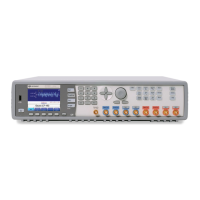For sine waveforms, signal imperfections are easiest to describe and
observe in the frequency domain using a spectrum analyzer. Any component
of the output signal which has a different frequency than the fundamental
(or “carrier”) is considered to be spurious. The signal imperfections can be
categorized as harmonic, non-harmonic, or phase noise and are specified in
“decibels relative to the carrier level” or “dBc”.
Harmonic components always appear at multiples of the fundamental
frequency and are created by non-linearties in the waveform DAC and other
elements of the signal path. At low amplitudes, another possible source of
harmonic distortion is due to the current flowing through the cable
connected to the function generator’s Strobe output connector. This current
can cause a small square-wave voltage drop across the resistance of the
cable’s shield and some of this voltage can be imposed on the main signal.
If this is a concern for your application, you should remove the cable. If your
application requires that you use the Strobe output connector, you can
minimize the effect by terminating the cable in a high impedance load
(rather than into a 50 load).

